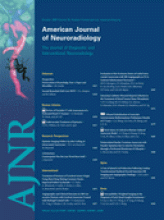Abstract
BACKGROUND AND PURPOSE: An ivy sign is considered to represent diffuse leptomeningeal collaterals found on fluid-attenuated inversion recovery (FLAIR) images of patients with Moyamoya disease. We evaluated the correlation between unilateral ivy proliferation in a hemisphere and cerebrovascular hemodynamic status to learn the clinical significance of the ivy sign.
MATERIALS AND METHODS: A total of 35 patients with Moyamoya disease were included. Correlation between ivy dominance on FLAIR images and hemodynamic status with use of iodine 123 N-isopropyl-p-iodoamphetamine (123I-IMP) single-photon emission CT (SPECT) was evaluated.
RESULTS: Distributional differences of ivy signs between both hemispheres were observed in 22 (64.7%) of 34 patients with a positive ivy sign, all of whom showed decreased vascular reserve/reactivity in the ivy-dominant hemisphere (IDH). The proportion of the stage II (misery perfusion) area to IDH was higher than that in the ivy less-dominant hemisphere (ILDH) in the quantitative analysis. The mean vascular reserve was lower in IDH than ILDH. There were 15 of 22 patients who had bypass surgery on IDH because of transient ischemic attack from ischemia of IDH. Patients with symmetric ivy distributions showed a variety of hemodynamic status. MR angiography (MRA) stage of IDH (2.95 ± 0.39) was higher compared with ILDH (2.60 ± 0.50; P < .05). Regional arteriocapillary circulation time ratio in IDH was longer compared with ILDH (P < .05). Ivy proliferation decreased in 10 (55.6%) of 18 patients who underwent bypass surgery during the follow-up period.
CONCLUSIONS: Unilateral hemispheric ivy proliferation correlated highly with the existence of an ipsilateral decreased vascular reserve associated with the development of leptomeningeal collaterals in patients with Moyamoya disease.
- Copyright © American Society of Neuroradiology












